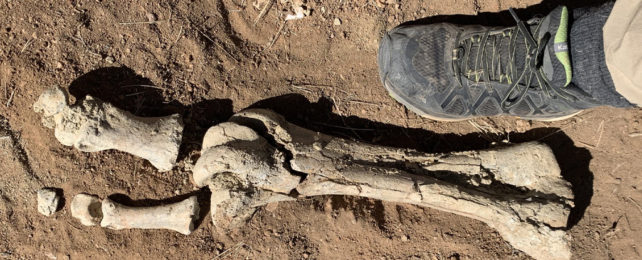A pair of legs belonging to what could be the largest bird species that ever stalked our planet have been unearthed from an outback fossil site in central Australia. Excitingly, more remains could still be laying nearby, waiting to be dug free.
Described by one paleontologist as an "extreme evolutionary experiment", Stirton's thunderbird (Dromornis stirtoni) is a patchwork of weird anatomical traits. Its oversized beak juts from an undersized skull, all perched on a body that towers 3 meters (10 feet) and weighs up to half a ton.
Just to make the animal sound even more absurd, these 8-million-year-old lumbering giants are actually related to modern day fowl, like chickens and ducks.
While the oversized 'demon ducks' are undoubtedly heavyweights, getting a precise measure on their size from jumbles of bones is easier said than done. This latest finding could take some of the guesswork out of models attempting to describe the true size ranges of Dromornis species.
For the first time remains of these massive flightless birds have been found articulated, laid out more or less how they existed inside the once living animal.
A huge moment at #alcoota2022 with the very first articulated -Dromornis stirtoni- leg excavated from Classy Corner. Thankyou @Phoebyornis for scale! #fossilfriday @fupalaeosoc @FlindersPalaeo pic.twitter.com/mJaKvacOtg
— Museum and Art Gallery of the Northern Territory (@MAG_NT) July 22, 2022
"What it means is that the carcass was entire when it was buried," paleontologist and curator of Earth sciences at the Museum and Art Gallery of the Northern Territory, Adam Yates, told ScienceAlert.
"We only got the lower legs because that's as far as we dug. There's every expectation that a large part of the rest of the skeleton – if not the entire skeleton – might be lying in the next dig as we dig further into the bank that the legs come from."
The fossilized bones were discovered in Alcoota Reserve, a dense fossil site 190 km north-east of Alice Springs featuring one of the largest concentrations of terrestrial vertebrate remains in Australia. While this location has yielded thousands of fossilized specimens since excavations began there in 1986, most of them have been jumbled fragments of different species thanks to historic flood waters mixing up the remains.
So most of the Alcoota fossils have required painstaking sorting into species and reconstructions involving parts of multiple individual animals. Such composite reconstructions necessarily involve a degree of creative thinking that introduce occasional mistakes.
"Even if you get all the species right – you put the right bones with the right species all together – you're still going to have proportional errors because of course there's natural variation between individuals," explains Yates.
The new legs are an exciting find because they can provide researchers with a much more accurate idea of these animals' true proportions. It will also help paleontologists better identify more D. stirtoni bones from the other jumbled fossils at Alcoota.
https://twitter.com/Samosthenurus/status/1565591492210864129
Flinders University paleontologist Warren Handley, Yates, and colleagues had previously compared an assortment of jumbled D. stirtoni bones discovered in the region and were able to identify a difference in size between males and females.
They took samples of the bones and identified a type of tissue called medullary bone in the smaller specimens. This is a temporary store of calcium that females draw from to shell their eggs, a feature males lack Yates explains.
Judging by the size of the newly discovered leg bones, the researchers suspect the remains belong to a female D. stirtoni, which the team have nicknamed Deb. They intend to do a histology test to confirm their suspicions.
Meanwhile, Deb's fossils are being prepared for temporary display at the museum later this year. Carefully cleaned and hardened with a plastic acetate filling any gaps, the bones will be preserved for future study.
Traces of thunderbirds have only ever been found in Australia, dating back to the late Miocene. These absurdly inflated chickens with small stubby wings lacked the specialized keeled sternum that other birds rely on for their large flight muscle attachments. They stalked dry woodlands and likely used their huge beaks to gobble up fruit and other vegetation.
Other herbivores found at Alcoota dated to the same time period include marsupials such as wallabies and ancient cow-sized wombat relatives.
These finds suggest D. stirtoni was the tall browser of this dry ecosystem, akin to today's camels – using its height to reach the vegetation beyond the grasp of its smaller fellow herbivores, Yates explains.
Back then, "it wasn't a mammal that stepped up to that role, it was a bird," says Yates.
Fossil records suggest these epic birds and their relatives existed for an incredible 25-million-year stretch of time. But at the end of the Miocene epoch Australia was drying up, perhaps too fast for D. stirtoni to adapt.
Yates notes that young thunderbird fossils are extremely rare to find, suggesting these animals did not have a fast rate of reproduction, producing possibly only one or two chicks a year. What's more, "it took an extraordinarily long time to mature for a bird. Dromornis took 15 years to reach adult size and sexual maturity."
These traits are well known for leaving animals vulnerable to changing environmental conditions.
The corner of the fossil deposit where the paleontologist found Deb also held an articulated wallaby, so Yates is keen to get back to the field next year. He is confident more of Deb is waiting to be discovered within the dirt bank, and there's an alluring possibility this site holds articulated fossils of unknown species too.
